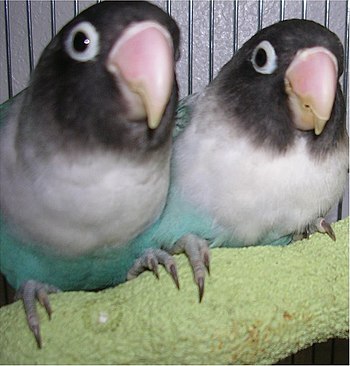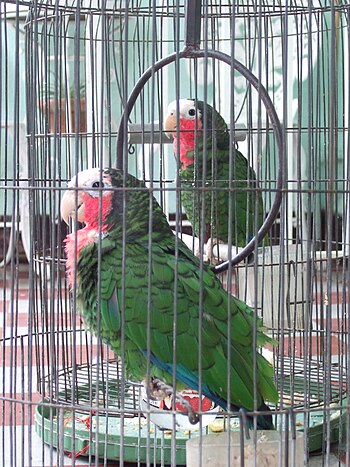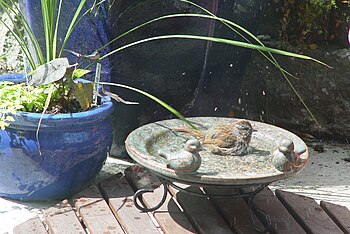| A cockatiel, Early, offering his head to be petted. (Photo credit: Wikipedia) |
Half the fun of owning
a cockatiel is teaching them to talk. You should keep in mind that some
individual birds are more adept at talking than others. This is one reason you
will really want to get to know and bond with your cockatiel before you try to
teach it its first word. Your bird will be more teachable if it is not tired or
stressed. You will want to teach your cockatiel in sessions when the bird is
happy and relaxed.
If you show perseverance in teaching your cockatiel to
talk then be assured even an older bird can learn to mimic a few words. You
should prepare your cockatiel for its first talking lesson by putting the bird
in an environment where it will not be distracted by other pets and noisy
children. You should also turn off competing noise such as televisions and
radios. You need to approach the bird with no abrupt movements and speak to it
in a soft voice. Using a soft voice is important because when you start
teaching your bird the first word you want it to learn you will be saying the
word distinctly and louder than the voice you normally use with your cockatiel.
Normally you will want to keep the bird in a location
where there is activity to keep the bird intellectually stimulated, but not
overwhelmed. If you can not clear the room the bird normally stays in then
moves the bird cage to a different quieter space. Give the bird a few moments
to take in its quieter surroundings. Then focus the cockatiel's attention
towards you.
The sex of the cockatiel has nothing to do with its
ability to learn to talk. Cockatiels of both sexes learn to talk at about the
same rate. Age does make a difference. Younger cockatiels will learn to speak
faster than older birds. It is important to realize the bird does not
understand the word it learns to speak. The cockatiel mimics words it hears by
rote. You may have noticed that your cockatiel will mimic the birds it hears in
the morning when it is near an open window. These sounds are the most natural
sounds for your cockatiel to mimic. It is sometimes easier to teach to birds to
whistle a familiar tune than teach it to speak a word in English. If you find
whistling annoying then you should not encourage it. Some experts feel
whistling impedes the birds desire to learn to speak.
Some bird trainers advocate training the bird on a perch
outside of the cage in front of the trainers face. Others advocate training the
cockatiel with the cage covered. There are merits to both methods as they both
focus the cockatiel on your voice. Pick only one word to teach to bird and repeat
it several times in a strong intonation. Introducing more than one word at a
time will confuse your bird. The bird must understand the sound as distinct and
separate from the other sounds it hears on a daily basis. This word need to
stand out from all the household background noise. Ideally you should work with
your bird for at least 20 minutes twice a day to teach it its first word. Once
you bird associates repeating this word with positive attention from you they
will repeat it again and again. Once the bird recognizes that it pleases you to
repeat certain sounds the next word you teach you bird will be repeated much
sooner.
It normally takes several weeks for even a young eager
cockatiel to learn to repeat words. The bird's name is often a good first word,
Avoid teaching your bird swear words. It may be funny at first but unless you
want that word repeated in front of house guests you will regret teaching your
bird to swear. Sometimes cockatiel will repeat swear word because that are
usually distinct words from the one's they usually hear and are normally say=id
by a person with great gusto.
Patience and perseverance are really the only really
proven ingredients to get you cockatiel to talk. I have heard people who have
not taught their birds to talk that they often will mimic common sounds like
the vacuum or the yelping of a small dog. Some of the sounds cockatiels make
are a hissing noise when they feel threatened. My two cockatiels whistle the
Andy of Mayberry song and make money sounds when they see the dog. I have no
idea where the monkey sounds came from. They also do a kissing noise when you
ask them for a kiss. We are working on them saying the phrase ", cats are
stupid." So far the male bird Captain Morgan say's "cats" and Marie
the female just swings and sings and makes kiss noises when you repeat
"cats". It is fairly evident to me that the process of learning to
talk varies a great deal from bird to bird.





























 Bird Cages Buying Guide
Bird Cages Buying Guide Pet Supplies Buying Guide
Pet Supplies Buying Guide Tips and Tricks for Surviving the Breeding Season with Parrots
Tips and Tricks for Surviving the Breeding Season with Parrots








